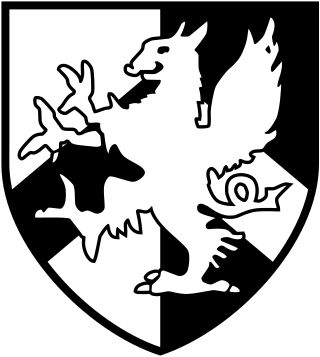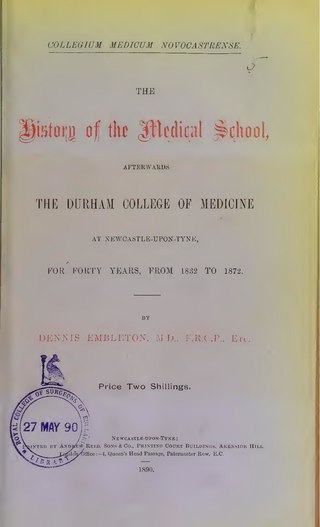
Addenbrooke's Hospital is a large teaching hospital and research centre in Cambridge, England, with strong affiliations to the University of Cambridge. Addenbrooke's Hospital is located on the Cambridge Biomedical Campus. It is run by Cambridge University Hospitals NHS Foundation Trust and is a designated academic health science centre. It is also the East of England's major trauma centre and was the first such centre to be operational in the United Kingdom.

Barts and The London School of Medicine and Dentistry, commonly known as Barts or BL, is a medical and dental school in London, England. The school is part of Queen Mary University of London, a constituent college of the federal University of London, and the United Hospitals. It was formed in 1995 by the merger of the London Hospital Medical College and the Medical College of St Bartholomew's Hospital.
A Bachelor of Medicine, Bachelor of Surgery is a medical degree granted by medical schools or universities in countries that adhere to the United Kingdom's higher education tradition. Despite the historical distinction in nomenclature, these degrees are typically combined and conferred together. This degree is usually awarded as an undergraduate degree, but it can also be awarded at graduate-level medical institutions. The typical duration for completion is five to six years.

In the United Kingdom, medical school generally refers to a department within a university which is involved in the education of future medical practitioners. All leading British medical schools are state-funded and their core purpose is to train doctors on behalf of the National Health Service. Courses generally last four to six years: two years of pre-clinical training in an academic environment and two to three years clinical training at a teaching hospital and in community settings. Medical schools and teaching hospitals are closely integrated. The course of study is extended to six years if an intercalated degree is taken in a related subject.

The Cardiff University School of Medicine is the medical school of Cardiff University and is located in Cardiff, Wales, UK. Founded in 1893 as part of the University College of South Wales and Monmouthshire, it is the oldest of the three medical schools in Wales.

The University of Medicine 1, Yangon, located in Yangon, it is the oldest medical school in Myanmar. The university offers M.B.B.S. degrees and graduate degrees in medical science. The university is perhaps the most selective university in the country, and admits approximately 400 students annually based on their University Entrance Examination scores.

Keele University School of Medicine is a medical school located in Newcastle-under-Lyme and Shrewsbury. The first two years of the school's MBChB degree are mostly taught on the Keele University campus, while early contact with patients is critical, and there is significant interaction in a clinical environment from the second year onwards.
The University of St Andrews School of Medicine is the school of medicine at the University of St Andrews in St Andrews, Fife, Scotland and the oldest medical school in Scotland.

Newcastle University School of Medicine is the medical school at Newcastle University in England. It was established in 1834 in the city of Newcastle upon Tyne and served as the College of Medicine in connection with Durham University from 1851 to 1870 and then, as a full college of the university, Durham University College of Medicine from 1870 to 1937 when it joined Armstrong College, to form King's College, Durham. In 1963 King's College became the University of Newcastle upon Tyne. The university now uses the name "Newcastle University".
Warwick Medical School is the medical school of the University of Warwick and is located in Coventry, United Kingdom. It was opened in 2000 in partnership with Leicester Medical School, and was granted independent degree-awarding status in 2007.

The UCD School of Medicine at University College Dublin, Ireland, was founded in 1854. At undergraduate level, the school offers programmes in Medicine MB BCh BAO, BSc Biomedical Health and Life Sciences, and the BSc Radiography. At graduate level, the school UCD offers over 40 programmes for health care professionals.

The Cambridge Biomedical Campus is the largest centre of medical research and health science in Europe. The site is located at the southern end of Hills Road in Cambridge, England.
Sir David Keith Peters is a retired Welsh physician and academic. He was Regius Professor of Physic at the University of Cambridge from 1987 to 2005, where he was also head of the School of Clinical Medicine.
Durham University School of Medicine, Pharmacy and Health was founded on Teesside in 2001 as a partner with the Newcastle University Medical School to educate medical students in the first phase of their medical education. On 1 August 2017 it was transferred to Newcastle University, becoming part of Newcastle's Faculty of Medical Sciences and relocating to Newcastle.

The University of Medicine 2, Yangon is a university of medicine, located in North Okkalapa, Yangon, Myanmar. The university offers M.B., B.S. degrees and graduate degrees in medical science. The university is one of the most selective in the country, and accepts approximately 300 students annually based solely on their University Entrance Examination scores.
New Jersey Medical School (NJMS)—also known as Rutgers New Jersey Medical School—is a medical school of Rutgers University, a public research university in Newark, New Jersey. It has been part of the Rutgers Division of Biomedical and Health Sciences since the 2013 dissolution of the University of Medicine and Dentistry of New Jersey. Founded in 1954, NJMS is the oldest school of medicine in New Jersey.
The University of Edinburgh Medical School is the medical school of the University of Edinburgh in Scotland and the United Kingdom and part of the College of Medicine and Veterinary Medicine. It was established in 1726, during the Scottish Enlightenment, making it the oldest medical school in the United Kingdom and the oldest medical school in the English-speaking world.
Sir John Gerald Patrick Sissons was an English physician, specialising in nephrology and virology, focusing on cytomegalovirus. He was aFRCP, FRCPath, FMedSci and Regius Professor of Physic at the University of Cambridge.
Joseph Stanley Mitchell, CBE, FRS, FRCP was a British radiotherapist and academic. He was Regius Professor of Physic at the University of Cambridge from 1957 to 1975.
Charles Nicholas "Nick" Hales was an English physician, biochemist, diabetologist, pathologist, and professor of clinical biochemistry












